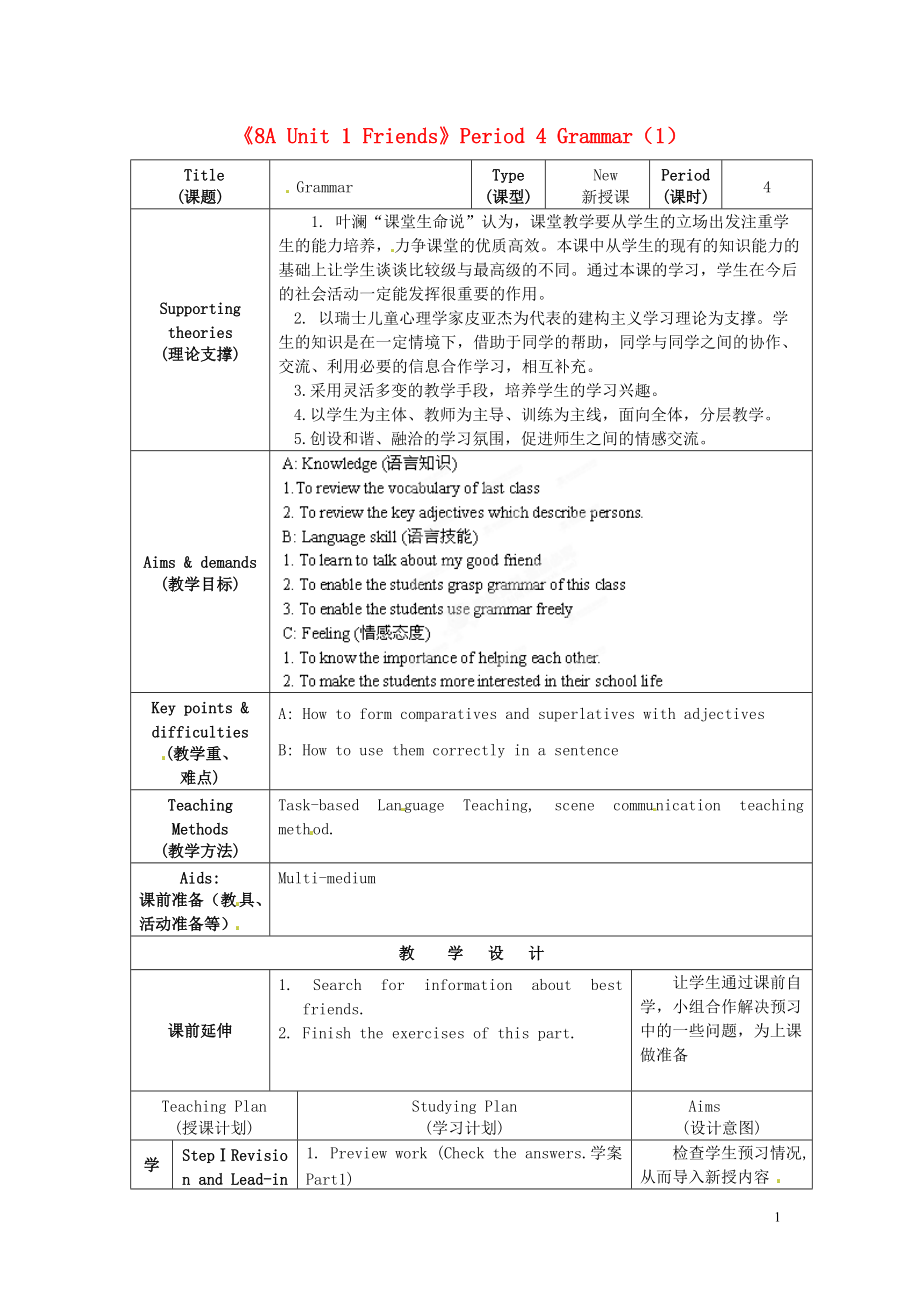《江蘇省海安縣大公初級(jí)中學(xué)八年級(jí)英語上冊(cè)《8A Unit 1 Friends》Period 4 Grammar(1)教案 牛津版》由會(huì)員分享����,可在線閱讀����,更多相關(guān)《江蘇省海安縣大公初級(jí)中學(xué)八年級(jí)英語上冊(cè)《8A Unit 1 Friends》Period 4 Grammar(1)教案 牛津版(3頁珍藏版)》請(qǐng)?jiān)谘b配圖網(wǎng)上搜索�����。
1����、8A Unit 1 FriendsPeriod 4 Grammar(1) Title(課題) GrammarType(課型)New新授課Period(課時(shí))4Supporting theories(理論支撐)1. 葉瀾“課堂生命說”認(rèn)為���,課堂教學(xué)要從學(xué)生的立場(chǎng)出發(fā)注重學(xué)生的能力培養(yǎng),力爭(zhēng)課堂的優(yōu)質(zhì)高效��。本課中從學(xué)生的現(xiàn)有的知識(shí)能力的基礎(chǔ)上讓學(xué)生談?wù)劚容^級(jí)與最高級(jí)的不同��。通過本課的學(xué)習(xí)���,學(xué)生在今后的社會(huì)活動(dòng)一定能發(fā)揮很重要的作用。2. 以瑞士?jī)和睦韺W(xué)家皮亞杰為代表的建構(gòu)主義學(xué)習(xí)理論為支撐。學(xué)生的知識(shí)是在一定情境下�����,借助于同學(xué)的幫助��,同學(xué)與同學(xué)之間的協(xié)作、交流�����、利用必要的信息合作學(xué)習(xí)��,相互補(bǔ)充����。
2、3.采用靈活多變的教學(xué)手段�����,培養(yǎng)學(xué)生的學(xué)習(xí)興趣�����。4.以學(xué)生為主體���、教師為主導(dǎo)���、訓(xùn)練為主線��,面向全體�����,分層教學(xué)����。5.創(chuàng)設(shè)和諧、融洽的學(xué)習(xí)氛圍���,促進(jìn)師生之間的情感交流��。Aims & demands(教學(xué)目標(biāo))Key points & difficulties(教學(xué)重���、難點(diǎn))A: How to form comparatives and superlatives with adjectivesB: How to use them correctly in a sentence Teaching Methods(教學(xué)方法) Task-based Language Teaching, scene com
3、munication teaching method.Aids: 課前準(zhǔn)備(教具����、活動(dòng)準(zhǔn)備等)Multi-medium教 學(xué) 設(shè) 計(jì)課前延伸1. Search for information about best friends.2. Finish the exercises of this part.讓學(xué)生通過課前自學(xué),小組合作解決預(yù)習(xí)中的一些問題�����,為上課做準(zhǔn)備Teaching Plan(授課計(jì)劃)Studying Plan(學(xué)習(xí)計(jì)劃)Aims(設(shè)計(jì)意圖)學(xué)StepRevision and Lead-in1. Preview work (Check the answers.學(xué)案Part1)2
4、. Ask students to say adjectives about someone or something檢查學(xué)生預(yù)習(xí)情況,從而導(dǎo)入新授內(nèi)容 導(dǎo)Step II Presenting 1. Ask students to finish the exercises of Part A on page 12.2 some situations on the use of comparatives3some situations on the use of superlatives4.the forms of comparatives and superlatives(1) Add “er
5�����、”or “est” behind most short adjectives (2) Add “r” or “st” behind short adjectives ending in “e”(3) Change “y” into “i” then add “er” or “est” behind short adjectives ending in a consonant +“y”(4Doubble the last consonant then add “er” or “est” behind short adjectives ending in a vowel + a consonant
6���、 (5)Add “more and more” in front of long adjectives.(6) Some special adjectivesgoodbetterbest wellbetterbestbadworseworst illworseworstbadlyworse-worstmany-moremost much-more-mostlittlelessleast farfartherfarthest自然過渡到新授課學(xué)習(xí),將重點(diǎn)內(nèi)容貫穿Step III Practicing 1. Ask students to read the five parts and rememb
7����、er them2. Have a competition to see which students are the best.3. More actions to help the poor.當(dāng)場(chǎng)讀記鞏固所學(xué),通過小組競(jìng)賽培養(yǎng)學(xué)生的團(tuán)隊(duì)合作精神練Step IV Production I. Exercises (學(xué)案練習(xí)課內(nèi)訓(xùn)練)學(xué)案練習(xí)鞏固本單元所學(xué)重點(diǎn)內(nèi)容,將英語教學(xué)落到實(shí)處課后提升Step V Homework1. Learn more about this unit by searching the Internet.2.學(xué)案配套練習(xí)(課后提升)控制作業(yè)量�����,既落實(shí)雙基���,又重視知識(shí)面的拓寬和能力的提升����,關(guān)心學(xué)生的認(rèn)知發(fā)展3
 江蘇省海安縣大公初級(jí)中學(xué)八年級(jí)英語上冊(cè)《8A Unit 1 Friends》Period 4 Grammar(1)教案 牛津版
江蘇省海安縣大公初級(jí)中學(xué)八年級(jí)英語上冊(cè)《8A Unit 1 Friends》Period 4 Grammar(1)教案 牛津版

